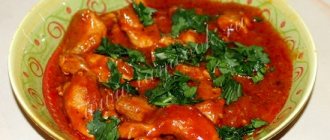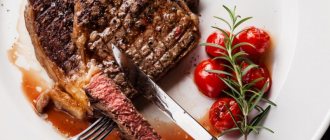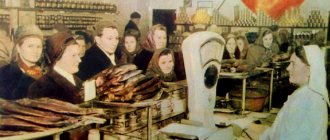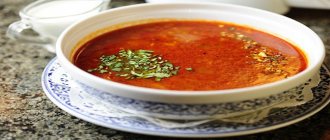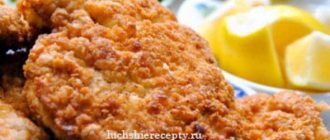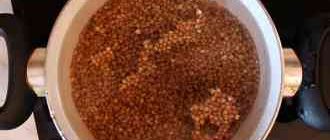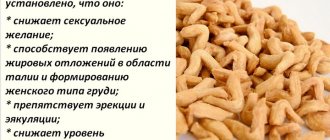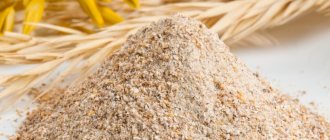Home-cured pork
You can make good jerky from other parts of pork, for example, from the neck.
- Take a large container and pour half the salt into it. Place the meat and cover with the other half of the salt. Place the container in the refrigerator for three days, covered with foil.
- Then remove the meat and rinse well under running water.
- Make a brine from apple cider vinegar, mixing it with a pinch of salt, four cloves of garlic crushed through a press, chopped rosemary, a teaspoon of ground red and black pepper.
- Immerse the meat in brine and leave for a couple of days.
- Next, the salted pork needs to be breaded. To do this, prepare a mixture of crushed fennel seeds, 100 g of salt, 20 g of ground black and red pepper.
- Wrap the breaded pork in parchment paper and tie it securely with string or twine. Additionally, wrap in a piece of cloth, then put in the refrigerator for up to a month.
- After 30 days, remove all wrapping layers. Wrap the finished piece of dried meat in a paper towel. Keep refrigerated.
Beef recipes
- 700 g beef;
- 100 g sweet pepper;
- 200 g carrots;
- 150 g onions;
- 300 g zucchini;
- 200 g cabbage;
- 15 g soy sauce;
- 20 g vegetable oil;
- salt and spices - to taste.
Cut the meat and fry it in a thick-bottomed pan, into which you first pour vegetable oil. Cut into half rings, grate, chop and send it all to the meat to stew. After a while, add chopped and diced vegetables to the meat and vegetables. When the meat is almost cooked, add the shredded meat and bring the dish until fully cooked.
Calorie content of beef stewed with vegetables is 105.8 kcal / 100 grams.
- 400 g beef brisket;
- 300 g cabbage;
- 100 g carrots;
- 200 g potatoes;
- 150 g tomatoes;
- 150 g beets;
- 50 g onions;
- 3 cloves of garlic;
- 10 g sunflower oil;
- 2 bay leaves;
- 3 liters of water;
- salt and pepper - to taste.
Boil beef broth, salt it and add cubes. Fry carrots and onions in a frying pan, add chopped tomato to them and simmer everything together a little. While the vegetables are stewing, grate them on a fine grater and also place them in the frying pan. Remove the meat from the broth and add the prepared vegetable dressing instead.
While the borscht is cooking over low heat, cut the meat into portions, chop the cabbage and peel the garlic. When the potatoes are almost cooked, add meat, cabbage to the borscht and cook for another 15 minutes. At the end of cooking, add the garlic crushed in a garlic press, turn off the heat and let the finished borscht brew for a while.
The calorie content of beef borscht is 30 kcal/100 grams.
- 500 g beef;
- 1 kg of rice;
- 300 g carrots;
- 300 g onions;
- 150 g garlic;
- 20 g vegetable oil;
- salt and pepper to taste.
Pour oil into the bottom of the cauldron and fry the meat cut into small pieces. After 5 minutes, add onions, carrots to the meat, add salt and pepper and simmer over medium heat for about 20 minutes. Then add whole peeled cloves of garlic to the cauldron, place washed garlic on top, add salt and add water so that the rice is covered by 1 finger. Simmer over low heat until all the water has evaporated.
The calorie content of pilaf with beef is 218 kcal / 100 grams.
- 200 g minced beef;
- 50 g onion;
- 1 chicken egg;
- 50 g bread;
- 50 g flour;
- salt to taste.
Soak the bread in water and then knead it with your hands until it becomes mushy. Grate the onion. In a bowl, mix the minced meat, onion, soaked bread, and add salt. Knead the minced meat thoroughly, form into small cutlets, carefully roll each one in flour and fry in a hot frying pan on both sides.
Calorie content of beef cutlets – 198 kcal / 100 grams.
- 1 kg beef;
- 3 tablespoons of tomato;
- 0.5 tablespoon of flour;
- 2 dining boats;
- 3 cloves of garlic;
- 3 onions;
- 30 g lard;
- 2 teaspoons salt;
- spices - to taste.
Cut the meat into small pieces. Fry the chopped meat in a frying pan, add the meat to it, after 5 minutes add the chopped onion and garlic. When the onions are golden, sprinkle the meat with flour and add tomato paste. Simmer the meat briefly in the tomato, then transfer the entire contents of the frying pan into a cauldron, add salt and your favorite spices, add water to cover the meat, and simmer over low heat for about an hour.
Calorie content of beef goulash – 166 kcal / 100 grams
.
- 800 g tenderloin;
- 50 g butter;
- salt and pepper - to taste.
Cut the meat into steaks approximately 4 cm thick. Melt in a hot frying pan. Season the steaks with salt and pepper and fry for 5 minutes on each side.
The calorie content of a beef steak is 220 kcal.
- 1 kg beef fillet;
- 100 ml vinegar;
- 1 liter of water;
- salt, pepper and spices - to taste.
Cut the meat into pieces, place in a deep pan, salt and add your favorite spices. Pour the contents of the pan with a mixture of vinegar and water and leave the kebab to marinate in the refrigerator overnight. Grill the kebab on the grill, pouring the marinade over the meat from time to time.
Calorie content of beef kebab is 172.5 kcal / 100 grams.
- 850 g minced beef;
- 700 g rice;
- 150 g carrots;
- 2 chicken eggs;
- 2 onions;
- 30 g vegetable oil;
- salt and spices - to taste.
Add fried onions and carrots to boiled rice, mix with minced meat and beat chicken eggs into the mixture. Season with salt and pepper and form into small patties. Fry the cutlets on both sides, and then simmer for 10 minutes under the lid.
Calorie content of beef meatballs with rice – 251 kcal / 100 g.
- 400 g beef;
- 200 g sour cream;
- 1 tablespoon starch;
- 1 onion;
- salt and pepper - to taste.
Beat the meat a little, cut into oblong pieces and sprinkle with starch. Fry the onion over high heat and add the meat to it. After 5 minutes, pour in sour cream, salt, add pepper and simmer for 20 minutes.
Calorie content of beef stroganoff is 147 kcal / 100 grams.
- 2 liters of beef broth;
- 300 g boiled beef;
- 1 carrot;
- 500 g potatoes;
- 1 onion;
- 1.5 cups peas;
- 2 tablespoons sunflower oil;
- salt, spices and herbs - to taste.
Boil the broth and add the meat cut into pieces. Rinse the soaked peas in water, place in a saucepan with broth and cook over low heat until the peas are ready.
Then add the potatoes, as well as the fried onions and carrots, to the pan. Boil the soup until the potatoes are fully cooked, then add salt, add spices, remove from heat and let sit for a few minutes before serving.
Calorie content of pea soup with beef is 77 kcal / 100 grams.
- 2 liters of beef broth;
- 1 kg of boiled beef;
- 1 teaspoon gelatin;
- 150 ml water;
- salt and pepper - to your taste.
Dissolve gelatin in water and let stand for about 15 minutes. Pour gelatin into the heated but not boiling broth, add salt and pepper to your taste. Place the meat cut into pieces into a jellied dish, pour in the broth, cool and refrigerate until completely thickened.
In fact, there are no healing foods, and beef is no exception. Remember that a sense of proportion should always accompany your gastronomic choice. Don’t get too carried away with statistics, but rather listen to your body and lose weight deliciously and with pleasure!
ribeye steak
rich in vitamins and minerals such as: vitamin B6 - 15.1%, vitamin B12 - 83.7%, vitamin PP - 18.1%, potassium - 11.9%, phosphorus - 19.6%, selenium - 30% , zinc - 44%
- Vitamin B6
is involved in maintaining the immune response, processes of inhibition and excitation in the central nervous system, in the transformation of amino acids, the metabolism of tryptophan, lipids and nucleic acids, promotes the normal formation of red blood cells, and maintaining normal levels of homocysteine in the blood. Insufficient intake of vitamin B6 is accompanied by decreased appetite, impaired skin condition, and the development of homocysteinemia and anemia. - Vitamin B12
plays an important role in the metabolism and transformation of amino acids. Folate and vitamin B12 are interconnected vitamins that are involved in hematopoiesis. A lack of vitamin B12 leads to the development of partial or secondary folate deficiency, as well as anemia, leukopenia, and thrombocytopenia. - Vitamin PP
is involved in redox reactions of energy metabolism. Insufficient vitamin intake is accompanied by disruption of the normal condition of the skin, gastrointestinal tract and nervous system. - Potassium
is the main intracellular ion that takes part in the regulation of water, acid and electrolyte balance, and is involved in the processes of conducting nerve impulses and regulating blood pressure. - Phosphorus
takes part in many physiological processes, including energy metabolism, regulates acid-base balance, is part of phospholipids, nucleotides and nucleic acids, and is necessary for the mineralization of bones and teeth. Deficiency leads to anorexia, anemia, and rickets. - Selenium
is an essential element of the antioxidant defense system of the human body, has an immunomodulatory effect, and is involved in the regulation of the action of thyroid hormones. Deficiency leads to Kashin-Beck disease (osteoarthritis with multiple deformities of the joints, spine and limbs), Keshan disease (endemic myocardiopathy), and hereditary thrombasthenia. - Zinc
is part of more than 300 enzymes and is involved in the processes of synthesis and breakdown of carbohydrates, proteins, fats, nucleic acids and in the regulation of the expression of a number of genes. Insufficient consumption leads to anemia, secondary immunodeficiency, liver cirrhosis, sexual dysfunction, and the presence of fetal malformations. Research in recent years has revealed the ability of high doses of zinc to disrupt the absorption of copper and thereby contribute to the development of anemia.
more hide
You can see the complete directory of the most useful products in the application
Beef steak is a ready-to-eat hot dish made from a thick cut of cattle meat. As a rule, meat from young animals of certain breeds is used for these purposes.
Manufacturing
The high cost of beef steaks is due to significant costs in the production of meat used for their preparation. Traditionally, meat from young bulls (no more than 1.5 years old), whose diet consists exclusively of corn or wheat, is used for these purposes. This allows you to obtain meat characterized by tender and juicy pulp with a low content of fatty tissue.
For the production of beef steaks, meat is suitable that is cut from those parts of the animal carcass that during its life were practically not involved in muscle movement. In this case, the meat is separated into thick pieces (3 to 5 cm thick) in the transverse direction. This cutting technology ensures a very even distribution of heat, significantly speeding up the process of cooking steak. It should also be noted that so-called “ripened” meat is used for its production. After cutting the animal, it is left in a room with a certain microclimate for several weeks, during which fermentation makes the muscle tissue more loose and tender.
Calorie content
100 grams of beef steak contains about 127 kcal.
Compound
Beef, salt, pepper, vegetable oil.
How to cook
Cooking beef steak involves the use of a special frying technology, which allows you to completely preserve the natural texture of the meat.
First, it is fried on a frying surface preheated to 250 degrees Celsius. In 15-20 seconds, a hard crust should form on the surface of the meat, after which it is transferred to the oven, in which the beef steak is baked at a temperature of 180-200 degrees to the desired degree of doneness: medium-rare - 4-5 minutes, medium-rare - 6- 7 minutes, almost done - 8-9 minutes, fried - 8-9 minutes, additional heat treatment in a combi oven.
How to serve
Beef steak is served either separately or with side dishes. In this capacity, as a rule, fried, boiled and stewed vegetable dishes serve.
What goes with it?
Beef steak goes well with most vegetables (cabbage, potatoes, carrots, legumes), cereals, eggs and baked goods and pasta.
How to choose
When choosing meat that you plan to use when cooking beef, you should pay attention to its appearance. The best choice would be meat from young animals, characterized by light (not bright) shades of red. In this case, you can guarantee that the final product will not be tasteless and tough.
Storage
Once cooked, beef steak should be stored in the refrigerator and consumed within a few days.
Beneficial features
Very aggressive heat exposure negatively affects the nutritional value of beef steak. However, when cooked, this dish contains quite a lot of biologically active substances that are of vital importance in the human diet. However, you can experience all the beneficial properties of beef steak only with moderate (not frequent) consumption of this dish. In particular, it stimulates the processes of hematopoiesis and the formation of bone and muscle tissue, and has antioxidant, anti-inflammatory, wound-healing, and immunostimulating effects.
Restrictions on use
Individual intolerance, cardiovascular diseases, disorders of the gastrointestinal tract, urolithiasis, gout, osteochondrosis.
So, steak translated from English means “piece of meat”. But it’s worth adding that this is a piece of good, high-quality meat. Not all parts of a cow, pig or sheep are suitable for cooking steak. For example, you would never make a steak from the shoulder, neck, or outer hind leg muscle. These parts of the animal's body are in constant motion, so the meat in them is tough. The best type of meat to cook steak is tenderloin. It is soft even in the oldest cow. Entrecote and other parts of meat located near the ridge can also be suitable for cooking steak.
Homemade jamon
Despite the fact that the Spaniards themselves have never made a secret of the technology for preparing their national delicacy - jamon, making it at home is not so easy.
You also need a well-ventilated room in which you can regulate the temperature to the nearest degree. That is, this is possible in a private house and unrealistic in a simple apartment.
Another disadvantage is the need to dry a whole pork leg, uncut, with all the bones, which is very troublesome in urban conditions. How can this be, since many people love jamon?
For such a case, a quick jamon recipe will come in handy. Of course, it is prepared not from ham, but from loin, but it will take much less time and effort.
- pork loin;
- salt;
- sugar;
- spices (bay leaf, black, red pepper, garlic, coriander).
- For the curing mixture, mix a glass of salt and half a glass of sugar. Grate the loin and place in a large flat bowl. Press down with a weight and place in the refrigerator for 3 days.
- Twice a day, the meat preparation must be turned over, and the liquid must be strained.
- Then dry the salted meat with paper towels and rub with a mixture of spices. For the mixture, crush several cloves of garlic through a press, take a teaspoon each of ground red, black pepper, coriander, and chopped bay leaf.
- Wrap the meat in gauze, tie it tightly with twine or twine, and hang it in a dark, ventilated place (balcony). In hot summers, it is better to put the product in the refrigerator for a day and return it in the evening.
- You can start tasting homemade jamon on the fourth day of ripening. However, it is better not to touch it for another couple of weeks, because each new day of drying will have a positive effect on its final taste.
- To slice it as thinly as possible, you can get a jamonera, a special device that allows you to get almost transparent slices, because jamon is not eaten like boiled sausage.
- After slicing, it is important to grease the cut of the remaining jamon with vegetable or melted butter to prevent chapping.
How to choose
When choosing a pork steak, pay attention to the following nuances:
- the meat must be fresh, chilled (i.e., look at the date of production and packaging, and also pay attention to storage conditions: usually steaks are stored in a refrigerator with an open display case, protected from weathering with stretch film, or vacuum-packed);
- the meat must be properly cut (the thickness of the portioned pieces is 3-4 cm);
- steak color: light pink, uniform;
- A “correct” steak should not contain coarse fibers or connective tissue - it is homogeneous flesh, in which a small amount of fatty layers is allowed.
Pork dried in the oven
You can effectively dry meat using a household oven.
- 1 kg pork meat;
- 10 g hot red pepper;
- 60 g salt.
- The meat must be washed well and dried. Place in the freezer until slightly frozen.
- Cut the pork across the grain into square pieces with a side of 5-7 cm.
- Grind the salt in a mortar along with red pepper.
- Rub the meat with the prepared mixture. Set aside for 20 minutes.
- Place the salted meat on a wire rack. The pieces should not touch each other.
- Place the rack in the oven. Dry at 70 degrees Celsius for 10 hours.
In addition to the oven, a grill is often used to dry pork. Among the spices, in addition to hot red pepper, bay leaves, star anise, cumin, and garlic are most suitable for this meat.
How many calories are in steak?
Here's how much:
The calorie content of beef steak, per 100 grams, is:
Proteins, fats and carbohydrates (BJU) in gr. per 100 grams:
Proteins - 18.3
Fats – 15.1
Carbohydrates – 0.0
If you prepare it according to this recipe:
Products:
- Beef - 500 g - (935 kcal)
- Vegetable oil - 1 tbsp. — (144 kcal)
- Salt, pepper - to taste.
How to cook:
- Cut the meat into large pieces weighing approximately 250 g.
- Lightly pound the beef with a kitchen hammer.
- Lubricate with vegetable oil on all sides.
- Place steaks on a hot grill pan.
- Sprinkle with salt, pepper and spices, fry for 3-4 minutes over medium heat. The temperature of the steak should not exceed 60 degrees.
- Turn over and fry the beef steaks for another 3-4 minutes.
A:
The calorie content of pork steak, per 100 grams, is:
Proteins, fats and carbohydrates (BJU) in gr. per 100 grams:
Proteins - 15.6
Fats – 25.1
Carbohydrates – 0.0
If you cook according to the previous recipe.
And here:
Calorie content of turkey steak, per 100 grams, is:
Proteins, fats and carbohydrates (BJU) in gr. per 100 grams:
Proteins - 18.6
Fats – 3.8
Carbohydrates – 0.0
If you cook according to the previous recipe.
A:
Calorie content of trout steak, per 100 grams, is:
Proteins, fats and carbohydrates (BJU) in gr. per 100 grams:
Proteins - 18.6
Fats – 5.1
Carbohydrates – 0.0
If you prepare it according to this recipe:
Products:
- Trout – 500 g – (485 kcal)
- Vegetable oil 1 tbsp. — (144 kcal)
- Spices - to taste.
How to cook:
- Place the steaks in a heated frying pan with oil, sprinkle with spices and fry on each side for 3-4 minutes.
- Cover the pan with a lid and fry for another 3-4 minutes.
And here:
Calorie content of salmon steak, per 100 grams, is:
Proteins, fats and carbohydrates (BJU) in gr. per 100 grams:
Proteins - 20.9
Fats – 8.9
Carbohydrates – 0.0
If you cook according to the previous recipe.
Great video with a great recipe. Worth a look!
And further:
You can fry the meat either on a grill pan, in the oven or over an open fire. After frying, the steak should be left for 5-7 minutes, covered loosely with a piece of foil, so that the juices are distributed in the meat and it becomes more tender.
Composition of pork
Poultry and beef do not have as much protein as pork. It is considered the building material of the body, thanks to it muscle and bone mass are formed, dead tissue in organs is replaced, and the balance of hormones is restored. Protein is especially important for physically active people.
Pork contains B vitamins. B1 improves immunity and promotes the active functioning of the nervous system, B2 breaks down fats and is involved in metabolism, B3 gives strength and energy, B5 protects the skin and mucous membranes from infections, B9 and B12 promote cell division and are necessary for normal functioning immune and nervous systems. The vitamin-like substance choline (B4), which is part of pork, protects cells from damage and destruction and reduces cholesterol levels in the blood.
The product contains vitamins D, E and A, amino acids, as well as useful minerals:
In 100 grams of pork, about 24% is protein, fats are approximately 11%, there are no carbohydrates or dietary fiber in the product. The calorie content of meat is 160 kcal; for lard this figure reaches 500 kcal.
Beef steak calories
Calorie content, depending on the part of the carcass you use, can vary from 190 to 300 kcal per 100 grams of product. Let's take the middle option. The calorie content of a beef steak is 220 kcal per 100 grams. The distribution of proteins, fats, carbohydrates is as follows: 3.10 g / 19.2 g / 15.3 g. As you can see, beef steak is rich in proteins and animal fats. This dish can be called healthy, and nutritionists advise eating beef even while on a diet. But if you are on a diet, choose lean parts of the cow and cook the steak without adding oil. Then it will not harm your figure, but, on the contrary, will become a source of sodium, potassium, phosphorus and selenium, which, in turn, will allow your body to more easily tolerate the diet and keep your nails, hair and teeth healthy and beautiful.
Beef, T-bone steak
rich in vitamins and minerals such as: vitamin B6 - 28.6%, vitamin B12 - 56%, vitamin PP - 25.8%, phosphorus - 22.1%, selenium - 36.4%, zinc - 27.7%
- Vitamin B6
is involved in maintaining the immune response, processes of inhibition and excitation in the central nervous system, in the transformation of amino acids, the metabolism of tryptophan, lipids and nucleic acids, promotes the normal formation of red blood cells, and maintaining normal levels of homocysteine in the blood. Insufficient intake of vitamin B6 is accompanied by decreased appetite, impaired skin condition, and the development of homocysteinemia and anemia. - Vitamin B12
plays an important role in the metabolism and transformation of amino acids. Folate and vitamin B12 are interconnected vitamins that are involved in hematopoiesis. A lack of vitamin B12 leads to the development of partial or secondary folate deficiency, as well as anemia, leukopenia, and thrombocytopenia. - Vitamin PP
is involved in redox reactions of energy metabolism. Insufficient vitamin intake is accompanied by disruption of the normal condition of the skin, gastrointestinal tract and nervous system. - Phosphorus
takes part in many physiological processes, including energy metabolism, regulates acid-base balance, is part of phospholipids, nucleotides and nucleic acids, and is necessary for the mineralization of bones and teeth. Deficiency leads to anorexia, anemia, and rickets. - Selenium
is an essential element of the antioxidant defense system of the human body, has an immunomodulatory effect, and is involved in the regulation of the action of thyroid hormones. Deficiency leads to Kashin-Beck disease (osteoarthritis with multiple deformities of the joints, spine and limbs), Keshan disease (endemic myocardiopathy), and hereditary thrombasthenia. - Zinc
is part of more than 300 enzymes and is involved in the processes of synthesis and breakdown of carbohydrates, proteins, fats, nucleic acids and in the regulation of the expression of a number of genes. Insufficient consumption leads to anemia, secondary immunodeficiency, liver cirrhosis, sexual dysfunction, and the presence of fetal malformations. Research in recent years has revealed the ability of high doses of zinc to disrupt the absorption of copper and thereby contribute to the development of anemia.
more hide
You can see the complete directory of the most useful products in the application
The benefits of pork
The beneficial properties of pork have a beneficial effect on many body systems. So, fresh lard:
- improves vision;
- helps with constipation;
- fights pulmonary diseases, pneumonia;
- removes heavy metal salts from the liver;
- participates in the development and maturation of blood cells.
Not everyone knows that pork is used not only as a culinary dish. Pork fat is used as a skin moisturizer. It is recommended to make a mask from it twice a week, especially in winter, when the skin is exposed to wind and cold.
In most cases, pork is excluded from the diet when people want to lose weight. In fact, a properly prepared meat dish promotes weight loss. To lose weight, choose pork tenderloin rather than neck or knuckle.
Pork meat has a positive effect on human health through the following systems:
Digestive system
The digestive organs simply need vitamins B1, B3, B6, B9 contained in pork. With a deficiency of these elements in the body, pathologies such as ulcerative colitis, liver infiltration, diarrhea and constipation, and intestinal atony can develop.
Boiled, baked and stewed meat contains more positive substances. In this form, it is better digested and takes second place in digestibility by the stomach, but raw pork is considered difficult to digest. Meat is recommended as a preventive therapy for gastritis and increased acidity of gastric juice.
central nervous system
Due to a lack of vitamins, disturbances in the functioning of the central system may occur. At the same time, a person is highly susceptible to stress, his mood changes for no reason. In this case, B vitamins, which pork is so rich in, are actively consumed.
It has a beneficial effect on the nervous system, restores balance, relieves irritability, improves mood, and helps in the fight against insomnia.
Bird
Poultry meat is the lowest in calories. 100 grams of chicken fried steak contains only 188 kcal, and turkey has even less - 137. Other indicators are also less than, for example, marbled beef. Therefore, chicken and turkey are considered dietary foods.
Of course, the meat, for example, in Steakhouse and Burger King is different, different cooking techniques are used and there is nothing to compare. Therefore, the calorie content of foods may vary. We recommend eating fried steaks only in places where you are guaranteed to be served a delicious dish.
ribeye steak
rich in vitamins and minerals such as: vitamin B6 - 15.1%, vitamin B12 - 83.7%, vitamin PP - 18.1%, potassium - 11.9%, phosphorus - 19.6%, selenium - 30% , zinc - 44%
- Vitamin B6
is involved in maintaining the immune response, processes of inhibition and excitation in the central nervous system, in the transformation of amino acids, the metabolism of tryptophan, lipids and nucleic acids, promotes the normal formation of red blood cells, and maintaining normal levels of homocysteine in the blood. Insufficient intake of vitamin B6 is accompanied by decreased appetite, impaired skin condition, and the development of homocysteinemia and anemia. - Vitamin B12
plays an important role in the metabolism and transformation of amino acids. Folate and vitamin B12 are interconnected vitamins that are involved in hematopoiesis. A lack of vitamin B12 leads to the development of partial or secondary folate deficiency, as well as anemia, leukopenia, and thrombocytopenia. - Vitamin PP
is involved in redox reactions of energy metabolism. Insufficient vitamin intake is accompanied by disruption of the normal condition of the skin, gastrointestinal tract and nervous system. - Potassium
is the main intracellular ion that takes part in the regulation of water, acid and electrolyte balance, and is involved in the processes of conducting nerve impulses and regulating blood pressure. - Phosphorus
takes part in many physiological processes, including energy metabolism, regulates acid-base balance, is part of phospholipids, nucleotides and nucleic acids, and is necessary for the mineralization of bones and teeth. Deficiency leads to anorexia, anemia, and rickets. - Selenium
is an essential element of the antioxidant defense system of the human body, has an immunomodulatory effect, and is involved in the regulation of the action of thyroid hormones. Deficiency leads to Kashin-Beck disease (osteoarthritis with multiple deformities of the joints, spine and limbs), Keshan disease (endemic myocardiopathy), and hereditary thrombasthenia. - Zinc
is part of more than 300 enzymes and is involved in the processes of synthesis and breakdown of carbohydrates, proteins, fats, nucleic acids and in the regulation of the expression of a number of genes. Insufficient consumption leads to anemia, secondary immunodeficiency, liver cirrhosis, sexual dysfunction, and the presence of fetal malformations. Research in recent years has revealed the ability of high doses of zinc to disrupt the absorption of copper and thereby contribute to the development of anemia.
more hide
You can see the complete directory of the most useful products in the application
Beef steak is a ready-to-eat hot dish made from a thick cut of cattle meat. As a rule, meat from young animals of certain breeds is used for these purposes.
Manufacturing
The high cost of beef steaks is due to significant costs in the production of meat used for their preparation. Traditionally, meat from young bulls (no more than 1.5 years old), whose diet consists exclusively of corn or wheat, is used for these purposes. This allows you to obtain meat characterized by tender and juicy pulp with a low content of fatty tissue.
For the production of beef steaks, meat is suitable that is cut from those parts of the animal carcass that during its life were practically not involved in muscle movement. In this case, the meat is separated into thick pieces (3 to 5 cm thick) in the transverse direction. This cutting technology ensures a very even distribution of heat, significantly speeding up the process of cooking steak. It should also be noted that so-called “ripened” meat is used for its production. After cutting the animal, it is left in a room with a certain microclimate for several weeks, during which fermentation makes the muscle tissue more loose and tender.
Calorie content
100 grams of beef steak contains about 127 kcal.
Compound
Beef, salt, pepper, vegetable oil.
How to cook
Cooking beef steak involves the use of a special frying technology, which allows you to completely preserve the natural texture of the meat.
First, it is fried on a frying surface preheated to 250 degrees Celsius. In 15-20 seconds, a hard crust should form on the surface of the meat, after which it is transferred to the oven, in which the beef steak is baked at a temperature of 180-200 degrees to the desired degree of doneness: medium-rare - 4-5 minutes, medium-rare - 6- 7 minutes, almost done - 8-9 minutes, fried - 8-9 minutes, additional heat treatment in a combi oven.
How to serve
Beef steak is served either separately or with side dishes. In this capacity, as a rule, fried, boiled and stewed vegetable dishes serve.
What goes with it?
Beef steak goes well with most vegetables (cabbage, potatoes, carrots, legumes), cereals, eggs and baked goods and pasta.
How to choose
When choosing meat that you plan to use when cooking beef, you should pay attention to its appearance. The best choice would be meat from young animals, characterized by light (not bright) shades of red. In this case, you can guarantee that the final product will not be tasteless and tough.
Storage
Once cooked, beef steak should be stored in the refrigerator and consumed within a few days.
Beneficial features
Very aggressive heat exposure negatively affects the nutritional value of beef steak. However, when cooked, this dish contains quite a lot of biologically active substances that are of vital importance in the human diet. However, you can experience all the beneficial properties of beef steak only with moderate (not frequent) consumption of this dish. In particular, it stimulates the processes of hematopoiesis and the formation of bone and muscle tissue, and has antioxidant, anti-inflammatory, wound-healing, and immunostimulating effects.
Restrictions on use
Individual intolerance, cardiovascular diseases, disorders of the gastrointestinal tract, urolithiasis, gout, osteochondrosis.
Beef, T-bone steak
rich in vitamins and minerals such as: vitamin B6 - 28.6%, vitamin B12 - 56%, vitamin PP - 25.8%, phosphorus - 22.1%, selenium - 36.4%, zinc - 27.7%
- Vitamin B6
is involved in maintaining the immune response, processes of inhibition and excitation in the central nervous system, in the transformation of amino acids, the metabolism of tryptophan, lipids and nucleic acids, promotes the normal formation of red blood cells, and maintaining normal levels of homocysteine in the blood. Insufficient intake of vitamin B6 is accompanied by decreased appetite, impaired skin condition, and the development of homocysteinemia and anemia. - Vitamin B12
plays an important role in the metabolism and transformation of amino acids. Folate and vitamin B12 are interconnected vitamins that are involved in hematopoiesis. A lack of vitamin B12 leads to the development of partial or secondary folate deficiency, as well as anemia, leukopenia, and thrombocytopenia. - Vitamin PP
is involved in redox reactions of energy metabolism. Insufficient vitamin intake is accompanied by disruption of the normal condition of the skin, gastrointestinal tract and nervous system. - Phosphorus
takes part in many physiological processes, including energy metabolism, regulates acid-base balance, is part of phospholipids, nucleotides and nucleic acids, and is necessary for the mineralization of bones and teeth. Deficiency leads to anorexia, anemia, and rickets. - Selenium
is an essential element of the antioxidant defense system of the human body, has an immunomodulatory effect, and is involved in the regulation of the action of thyroid hormones. Deficiency leads to Kashin-Beck disease (osteoarthritis with multiple deformities of the joints, spine and limbs), Keshan disease (endemic myocardiopathy), and hereditary thrombasthenia. - Zinc
is part of more than 300 enzymes and is involved in the processes of synthesis and breakdown of carbohydrates, proteins, fats, nucleic acids and in the regulation of the expression of a number of genes. Insufficient consumption leads to anemia, secondary immunodeficiency, liver cirrhosis, sexual dysfunction, and the presence of fetal malformations. Research in recent years has revealed the ability of high doses of zinc to disrupt the absorption of copper and thereby contribute to the development of anemia.
more hide
You can see the complete directory of the most useful products in the application
So, steak translated from English means “piece of meat”. But it’s worth adding that this is a piece of good, high-quality meat. Not all parts of a cow, pig or sheep are suitable for cooking steak. For example, you would never make a steak from the shoulder, neck, or outer hind leg muscle. These parts of the animal's body are in constant motion, so the meat in them is tough. The best type of meat to cook steak is tenderloin. It is soft even in the oldest cow. Entrecote and other parts of meat located near the ridge can also be suitable for cooking steak.
HEALTHY PROPERTIES OF BEEF STEAK WITH EGG, 1-402 each
Friends Add and remove friends, view friend requests and comments to them. Open diaries View open diaries of nutrition, exercise, diet statistics. Personal diary In your personal account, you can record scale and centimeter readings, look at weight and volume graphs, and make entries in your diary.
Profile In the profile section you can change your avatar, date of birth, time zone and set diary publishing settings. Personal diary.
All food groups: calories, proteins, fats, carbohydrates
Food diary Food diary My products My recipes Diet statistics. Exercise diary Exercise diary My exercises. Results My measurements My results My graphs History of weight changes.
Caloric content of products The caloric content of products section includes a database of products by calories, proteins, fats, carbohydrates.
Complete table of caloric content of foods The caloric content table allows you to find out the amount of calories, proteins, fats, carbohydrates in various foods. Calorie content of products by category For convenient viewing of calorie content, all products are divided into categories. Calorie content of restaurants Constantly updated section about the calorie content of fast food, fast food restaurants, Japanese cuisine.
Vitamins in foods Table of vitamin content in foods with search, sorting and filtering by any vitamin. Recipes with calorie content The table of calorie content of dishes and recipes contains information about calorie content, proteins, fats, carbohydrates, portions, cooking methods and processing losses.
Pork neck steak
Chicken egg - 1 pc. Vegetable oil - 50 gr. Salt - 8 gr.
This is a custom recipe, so there may be errors and typos. If you find them, please write them in the comments below the recipe and we will correct them. Chopped beefsteak. Finely chop the beef with a knife. Add egg, salt, pepper and very finely chopped onion. Mix thoroughly.
Ground black pepper - 5 gr. Proteins: Fats: Carbohydrates: 2. Agusha natural drinking yogurt 3. Non-alcoholic beer.
Buitoni lasagne sheets. Apple jelly. Mashed potatoes Babushkino Lukoshko Beef Vegetables.
